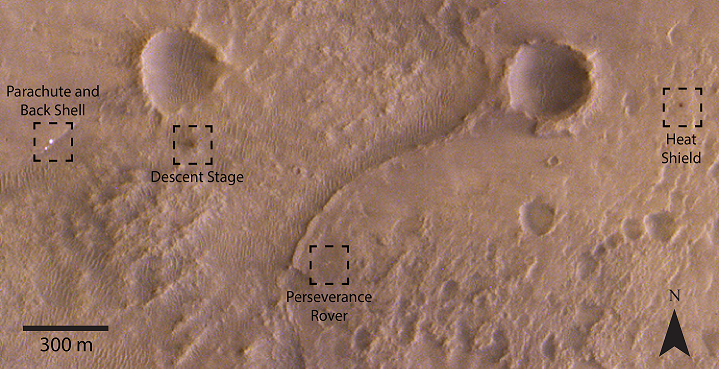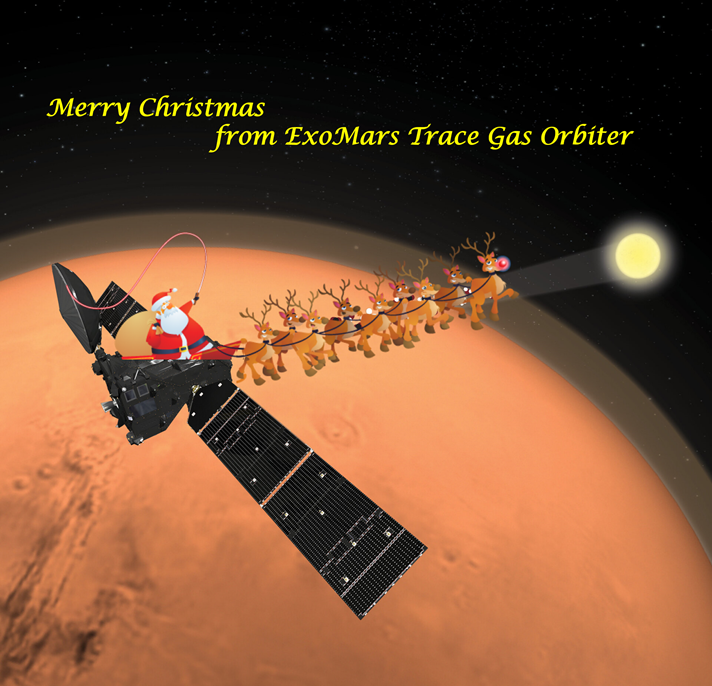Here is the team exploring the Life Science Centre in Newcastle Upon Tyne for the 25th Science Working Team meeting.


There has been much public interest in the recent NOMAD results presenting the green nightglow on Mars. Below is a list of websites that have mentioned the story:
https://twitter.com/esaspaceflight/status/1722882623905702101
https://www.sciences.uliege.be/cms/c_12066296/fr/une-emission-lumineuse-dans-le-domaine-visible-detectee-pour-la-premiere-fois-dans-la-nuit-martienne
https://www.sciences.uliege.be/cms/c_12066296/en/glow-in-the-visible-range-detected-for-the-first-time-in-the-martian-night
https://isp.page/news/european-satellite-spots-mysterious-glow-coming-from-mars-2/
https://thedebrief.org/european-satellite-spots-mysterious-glow-coming-from-mars/
https://www.earth.com/news/the-martian-sky-often-has-an-eerie-green-glow-at-night-called-nightglow/
https://phys.org/news/2023-11-visible-range-martian-night.html
https://www.eurekalert.org/news-releases/1007396
https://www.newsweek.com/scientists-observe-never-before-seen-green-glow-mars-night-sky-1842768
https://www.sciencedaily.com/releases/2023/11/231109121558.htm
https://www.numerama.com/sciences/1556534-voila-a-quoi-ressemblera-le-ciel-pour-un-astronaute-aux-poles-de-mars.html
https://bnn.network/tech/science-tech/green-glow-on-mars-a-new-spectacle-in-the-martian-sky/
https://www.bullfrag.com/the-night-sky-of-mars-lights-up-with-a-green-glow/?utm_content=cmp-true
https://www.terra.com.br/byte/ciencia/espaco/sonda-da-esa-detecta-luz-verde-na-atmosfera-de-marte,040f744972d75c2904d416268e5ff7d29xr180qm.html
https://canaltech.com.br/espaco/sonda-da-esa-detecta-luz-verde-na-atmosfera-de-marte-269717/
https://www.eltiempo.com/vida/ciencia/los-cielos-de-marte-se-vieron-con-un-resplandor-verde-de-que-se-trata-824772
https://www.europapress.es/ciencia/misiones-espaciales/noticia-resplandor-verde-ilumina-cielo-nocturno-marte-20231110114301.html
https://hipertextual.com/2023/11/el-cielo-nocturno-de-marte-se-ilumina-con-un-brillante-resplandor-verde
https://800noticias.com/el-cielo-nocturno-de-marte-se-ilumina-con-de-verde
https://www.semana.com/tecnologia/articulo/cientificos-estan-intrigados-con-el-extrano-resplandor-verde-que-aparecio-en-el-cielo-de-marte/202343/
https://www.elimparcial.com/tecnologia/Marte-se-ilumina-de-verde-20231110-0070.html
https://www.infobae.com/america/agencias/2023/11/10/un-resplandor-verde-ilumina-el-cielo-nocturno-en-marte/
https://www.diariodesevilla.es/tecnologia/resplandor-verde-ilumina-nocturno-Marte_0_1846917326.html
https://it.eseuro.com/tecnologia/amp/1142334
https://www.media.inaf.it/2023/11/10/bagliori-nella-notte-marziana/
https://www.scienzenotizie.it/2023/11/11/la-prima-rilevazione-del-bagliore-notturno-su-marte-5673467
https://www.nouvelles-du-monde.com/le-ciel-nocturne-de-mars-sillumine-dune-lueur-verte/
https://nouvellefr.com/les-scientifiques-observent-une-lueur-verte-jamais-vue-auparavant-dans-le-ciel-nocturne-de-mars/
https://www.futura-sciences.com/sciences/actualites/mars-etranges-lueurs-nocturnes-detectees-ciel-mars-109062/
https://ts2.space/en/mars-unveils-a-spectacular-nighttime-show-visible-light-nightglow/
https://ts2.space/en/illuminating-the-martian-skies-understanding-mars-green-nightglow/#gsc.tab=0
https://www.iflscience.com/martian-polar-nights-will-glow-green-for-future-astronauts-71505
https://www.techeblog.com/esa-green-nightglow-mars/
https://sciencepost.fr/lueur-verte-guider-futurs-astronautes-mars/
https://www.space.com/mars-nightglow-exomars-esa-visible-light
https://www.notimerica.com/ciencia-tecnologia/noticia-resplandor-verde-ilumina-cielo-nocturno-marte-20231110114337.html
https://www.youtube.com/watch?v=upAID91hEpU
https://turkish.aawsat.com/teknoloji/4664031-mars-astronotları-yeşil-bir-gökyüzü-görebilir
https://olhardigital.com.br/2023/11/11/ciencia-e-espaco/noites-polares-de-marte-tem-brilho-esverdeado-entenda/
https://ground.news/article/a-green-glow-in-the-martian-night_cad66c
https://www.newquayweather.com/wxesanewsrss.php
https://www.cronica.com.mx/academia/resplandor-verde-ilumina-cielo-nocturno-marte.html
https://sains.sindonews.com/read/1249101/767/misterius-penampakan-cahaya-hijau-di-langit-malam-mars-1699701073
https://tek.sapo.pt/noticias/ciencia/artigos/brilho-noturno-verde-visto-pela-primeira-vez-na-atmosfera-de-marte
https://www.unexplained-mysteries.com/forum/topic/372098-a-green-glow-in-the-martian-night/
https://gettotext.com/why-the-sky-is-sometimes-green-on-mars/
https://www.crumpe.com/2023/11/lueur-dans-le-domaine-visible-detectee-pour-la-premiere-fois-dans-la-nuit-martienne/
https://www.gamingdeputy.com/the-reasons-behind-the-occasional-green-sky-on-mars/
https://www.diariodigital.com.do/2023/11/10/descubrimiento-en-marte-resplandor-nocturno-ilumina-atmosfera-marciana.html/
https://mondo.me/MobIT/Vijesti/a1204110/Zasto-je-nocno-nebo-na-Marsu-nekada-zelene-boje.html
https://thespaceway.info/space/23328-esa-trace-gas-orbiter-zafiksiroval-nochnoe-sijanie-atmosfery-marsa-v-vidimom-svete.html
https://www.noticiasrcn.com/tecnologia/fenomeno-se-registro-en-el-planeta-marte-458188
https://www.sci.news/space/esas-trace-gas-orbiter-green-atmospheric-nightglow-mars-12441.html
https://www.spacechatter.com/2023/11/13/mars-glowing-lights/
https://planoinformativo.com/961591/la-atmosfera-de-marte-se-tine-de-verde
https://www.lasexta.com/tecnologia-tecnoxplora/ciencia/resplandor-verde-ilumina-cielo-nocturno-marte-puede-observarse-tierra_2023111365520e46b276150001aeb5ca.html
https://www.europapress.es/temas/marte/
https://optics.org/news/14/11/17
https://www.scienzenotizie.it/2023/11/12/il-cielo-si-tinge-di-verde-su-marte-limmagine-della-sonda-dellesa-3173504
https://gadgettendency.com/surprising-things-on-mars-space-probe-shows-the-red-planet-glowing-green/
https://engineeringnet.be/fr/actualites/item/22162
https://www.marsdaily.com/reports/A_green_glow_in_the_Martian_night_999.html
https://www.marsdaily.com/reports/Glow_in_the_visible_range_detected_for_the_first_time_in_the_Martian_night_999.html
https://sputnikglobe.com/20231119/red-planet-green-glow-light-emission-phenomenon-spotted-in-martian-sky-1115055995.html
https://www.archyde.com/discovering-martian-airglow-the-latest-news-from-al-qalaa/
https://www.universetoday.com/164263/martian-green-nightglow-seen-for-the-first-time/#more-164263
https://ordonews.com/mysterious-green-glow-in-the-night-sky-of-mars-was-captured-by-an-orbiter/
https://timesofindia.indiatimes.com/home/science/astronauts-on-red-mars-may-witness-green-sky-reveals-study/articleshow/105316988.cms
https://scientias.nl/groene-gloed-ontdekt-in-de-nachthemel-van-mars-en-dat-is-goed-nieuws-voor-astronauten/
https://www.huffingtonpost.es/planeta/la-noche-marciana-muestra-primera-vez-misteriosa-cara-verdebr.html
https://scitechdaily.com/mars-unveils-its-nighttime-secret-mesmerizing-green-glow-discovered/
https://www.sciencealert.com/eerie-green-night-sky-discovered-on-mars-could-guide-future-explorers
https://www.wionews.com/science/in-a-first-scientists-detect-eerie-green-glow-in-night-sky-of-mars-659465
https://futurism.com/the-byte/mars-glowing-green
https://www.sciencetimes.com/articles/47153/20231117/esas-exomars-mission-captures-unexpected-green-light-martian-sky-visible.htm
https://ground.news/article/mars-unveils-its-nighttime-secret-mesmerizing-green-glow-discovered
https://globalhappenings.com/technology/442425.html
https://www.pressreader.com/uk/the-herald-1130/20231117/281809993628863
https://time.news/esa-exomars-trace-gas-orbiter-detects-green-glowing-atmosphere-on-mars-for-the-first-time-in-visible-light/
https://metro.co.uk/2023/11/17/strange-green-glow-mars-help-first-human-explorers-19837986/
https://themessenger.com/tech/scientists-spot-eerie-green-light-in-mars-sky
https://southfloridareporter.com/mars-probe-sees-red-planet-atmosphere-glowing-green-at-night/
https://www.inverse.com/science/the-martian-night-sky-glowing-eerie-green-right-now
https://anomalien.com/mysterious-green-glow-in-the-sky-of-mars-was-captured-by-an-orbiter/
https://www.gbnews.com/news/mars-probe-rare-space-phenomenon-red-planet-pictures
https://www.townoflaronge.ca/mars-reveals-its-nocturnal-secret-discovering-its-magical-green-glow/
https://www.zenger.news/2023/11/16/esas-exomars-mission-detects-visible-nightglow-in-martian-atmosphere/
https://hindi.news18.com/news/ajab-gajab/green-night-sky-seen-on-mars-european-space-agency-scientists-surprised-reason-for-mysterious-glow-discovered-7837040.html
https://www.donanimhaber.com/mars-atmosferinin-ilk-kez-yesile-burundugu-tespit-edildi--170989
https://vervetimes.com/new-study-suggests-astronauts-on-mars-might-see-a-green-sky-adding-to-the-eerie-experience/
https://hungary.postsen.com/technology/317887/The-sky-of-Mars-lights-up-green-instead-of-blue.html
https://charmingscience.com/for-the-first-time-researchers-have-detected-an-eerie-green-glow-has-in-the-night-sky-of-mars/
https://india07.in/green-night-sky-seen-on-mars-scientists-surprised-reason-for-mysterious-glow-discovered/
https://www.tiempo.com/noticias/actualidad/que-son-estas-misteriosas-luces-que-iluminan-el-cielo-nocturno-marciano.html
https://issues.fr/mars-devoile-son-secret-nocturne-decouverte-dune-lueur-verte-fascinante/
https://www.dubaiweek.ae/nocturnal-ventilation-on-mars-and-its-importance-in-exploring-the-red-planet/
https://en.news4social.com/science-2/astronauts-on-red-mars-could-witness-environmentally-friendly-sky-reveals-study-moments-of-india/
https://greatlakesledger.com/2023/11/16/green-light-over-mars-see-incredible-glow-captured-for-the-first-time/
https://news.yahoo.com/scientists-catch-mars-glowing-green-093034098.html?guccounter=1&guce_referrer=aHR0cHM6Ly93d3cuZ29vZ2xlLmJlLw&guce_referrer_sig=AQAAALdEdHAALV1gIO6_I_LbO5Dc-T5Kyj_xtK1Ujc5NedovaigChGds86UhRaD3CVLL8Ksu96gFxhVFY-XiRSbUPV80nEUTgW5xh1nl1jM58Fc6F92PKHls4vnrTFn1S_s_-dzyLE8jQvAACvDgftKkW1me6l1AUE4skK-fjF-Ur1O2
https://menafn.com/1107437178/Scientists-sees-Mars-atmosphere-glowing-green-in-visible-light-spectrum
https://aussiedlerbote.de/en/the-red-planet-glows-green/
https://fr.italy24.press/technology/amp/109374
https://interestingengineering.com/science/esa-orbiter-detects-martian-night-sky-turning-green-for-first-time#
https://www.techtimes.com/articles/298744/20231116/mars-red-planet-esa-detects-green-glow-martian-night-sky.htm
https://www.yourweather.co.uk/news/trending/mysterious-lights-illuminate-martian-night-sky-what-are-they-astronomy.html
https://www.technology.org/2023/11/16/a-green-glow-in-the-martian-night/
https://interestingengineering.com/science/esa-orbiter-detects-martian-night-sky-turning-green-for-first-time#
https://www.msn.com/en-gb/news/techandscience/mars-probe-sees-red-planet-atmosphere-glowing-green-at-night/ar-AA1jYBEZ
https://www.thesun.co.uk/tech/24756730/green-night-glow-mars-space-explorers/
https://bnn.network/tech/science-tech/mars-atmosphere-shines-green-a-cosmic-spectacle-with-deep-implications/
https://www.reddit.com/r/space/comments/17w5n2n/mars_probe_sees_red_planet_atmosphere_glowing/?rdt=60329
https://www.newsdirectory3.com/discovery-of-green-airglow-on-mars-implications-for-future-space-exploration/
https://www.aroged.com/2023/11/16/a-mysterious-green-glow-was-recorded-in-the-atmosphere-of-mars-oxygen-molecules-are-probably-formed-there/
https://www.astrotreff.de/forum/index.php?thread/286439-esa-s-marssonde-sieht-nachts-grün-leuchtende-atmosphäre-des-roten-planeten/
https://www.tz.de/wissen/mars-roter-planet-esa-tgo-leuchtet-gruen-farbenspiel-nachts-studie-weltraum-92678137.html
https://www.op-online.de/welt/mars-roter-planet-leuchtet-gruen-nightglow-sauerstoff-sonne-atmosphaere-astronauten-sehen-zr-92677660.html
https://www.youtube.com/watch?v=p_YxHxxmymU
https://noticiasambientales.com/ciencia/un-resplandor-verde-ilumina-el-cielo-nocturno-en-marte/
https://explorersweb.com/green-sky-mars/
https://www.extremetech.com/science/scientists-spot-mars-green-night-sky-via-the-visible-light-spectrum
https://ts2.space/en/discovering-the-emerald-twilight-of-mars/#gsc.tab=0
https://ncrnoticias.com/curiosidades/asi-se-ve-el-sorprendente-cielo-verde-que-ilumino-marte/
https://www.meteogiornale.it/2023/11/20/un-bagliore-verde-illumina-il-cielo-notturno-su-marte/
https://tg.la7.it/scienza-e-tecnologia/lo-spettacolare-bagliore-su-marte-per-la-prima-volta-visibile-dalla-sonda-tgo-17-11-2023-198978
https://www.ngenespanol.com/el-espacio/asi-luce-el-impresionante-cielo-verde-de-marte-el-planeta-rojo/
https://www.nextme.it/bagliore-verde-su-marte-misterioso-fenomeno-prima-volta/
https://www.globalscience.it/47378/exomars-osserva-le-emissioni-luminose-nellatmosfera-di-marte/
https://www.ansa.it/canale_scienza/notizie/spazio_astronomia/2023/11/17/su-marte-un-bagliore-notturno-illumina-il-cielo-di-verde-_90161ff6-117f-4f36-b6a3-8df9e11c2bea.html
https://www.ecodibergamo.it/stories/scienza-e-tecnologia/su-marte-bagliore-notturno-illumina-cielo-verde-o_1819700_11/
https://www.science-et-vie.com/ciel-et-espace/mars-une-sonde-spatiale-detecte-une-etrange-lueur-verte-dans-son-atmosphere-118788.html
https://www.techno-science.net/actualite/mars-elle-rouge-verte-N24024.html
https://exomars.cnes.fr/fr/exomars-repere-une-lueur-verte-unique-sur-la-planete-rouge
https://www.todayinliege.be/les-chercheurs-de-luliege-impliques-dans-une-decouverte-majeure-concernant-la-planete-mars/
When future astronauts explore Mars’s polar regions, they will see a green glow lighting up the night sky. For the first time, a visible nightglow has been detected in the martian atmosphere by ESA’s ExoMars Trace Gas Orbiter (TGO) mission.
For more information, see the ESA press release here
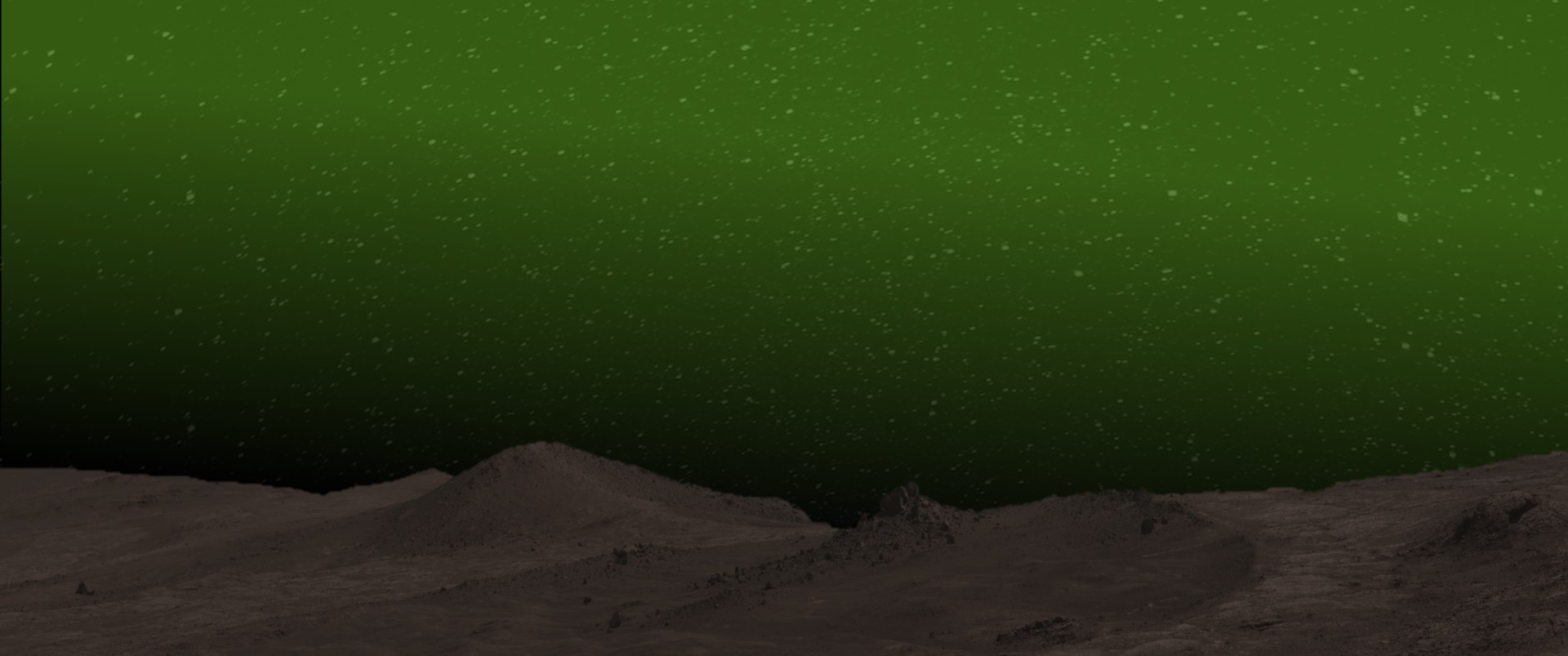
18 Feb 2021
NASA's latest and most complex mission to the Red Planet has touched down at Jezero Crater. Now it's time to begin testing the health of the rover.
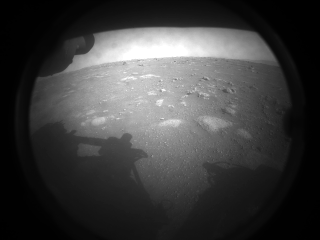
ESA Trace Gas Orbitor will be providing assistance as a data relay for the lander.
The full NASA press release can be found here.
Approximately every two years, TGO takes a break for a couple of weeks as Mars passes behind the Sun, making communication between Earth and Mars unreliable. The latest conjunction started on 8th November 2023 and ends on the 29th November; during this time TGO will remain in a stable orbit with all non-essential systems switched off, waiting for a signal to be received from Earth.
This affects all spacecraft and rovers at Mars. Find out more information here: https://mars.nasa.gov/all-about-mars/night-sky/solar-conjunction/
A major quest in Mars exploration is hunting for atmospheric gases linked to biological or geological activity, as well as understanding the past and present water inventory of the planet, to determine if Mars could ever have been habitable and if any water reservoirs could be accessible for future human exploration. Two new results from the ExoMars team published today in Science Advances unveil an entirely new class of chemistry and provide further insights into seasonal changes and surface-atmosphere interactions as driving forces behind the new observations.
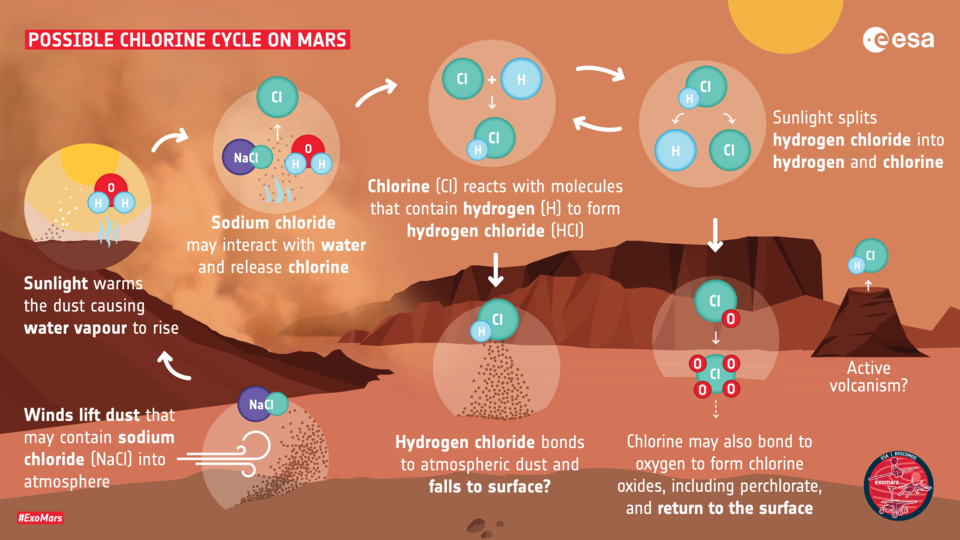
As well as new gases, the Trace Gas Orbiter is refining our understanding of how Mars lost its water – a process which is also linked to seasonal changes. Liquid water is once thought to have flowed across the surface of Mars as evidenced in the numerous examples of ancient dried out valleys and river channels. Today, it is mostly locked up in the ice caps and buried underground. Mars is still leaking water today, in the form of hydrogen and oxygen escaping from the atmosphere. Understanding the interplay of potential water-bearing reservoirs and their seasonal and long-term behavior is key to understanding the evolution of the climate of Mars. This can be done through the study of water vapour and ‘semi-heavy’ water (where one hydrogen atom is replaced by a deuterium atom, a form of hydrogen with an additional neutron).
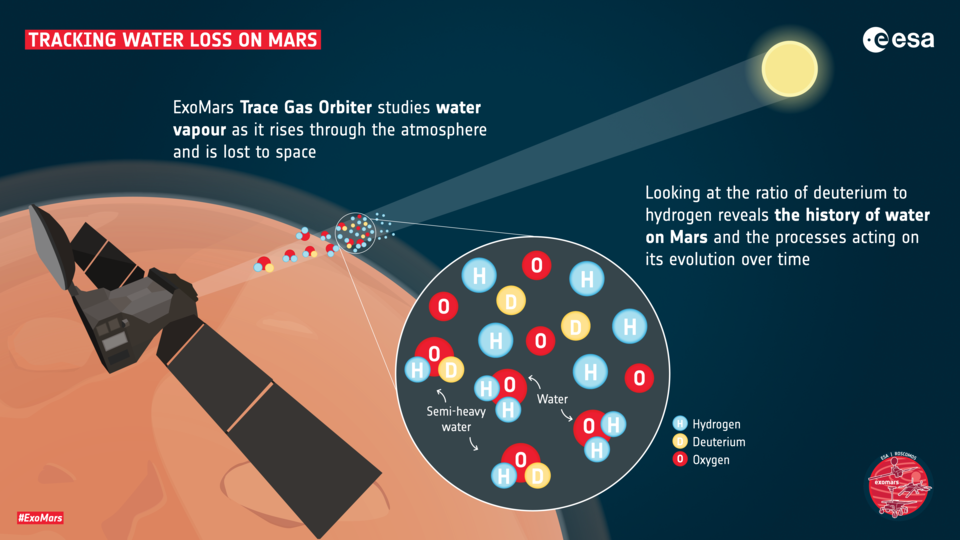
The full press release on the ESA website can be found here.
In addition, two article were recently publishes:
The 24th NOMAD Science Working Team meeting was held at the University of Basilicata, Potenza, in September 2023.

BELSPO, the Belgian federal science policy office, has created a virtual expo describing the long journey of NOMAD from first concept to current mission around Mars.
The expo is available in french by clicking here, or in dutch by clicking here.
Last week, the NOMAD team were in Matsushima, Japan. Thanks to everyone for an amazing week!

ESA’s ExoMars Trace Gas Orbiter has detected glowing green oxygen in Mars’ atmosphere – the first time that this emission has been seen around a planet other than Earth. “One of the brightest emissions seen on Earth stems from night glow. More specifically, from oxygen atoms emitting a particular wavelength of light that has never been seen around another planet,” says Jean-Claude Gérard of the Université de Liège, Belgium, and lead author of the new study published in Nature Astronomy. “However, this emission has been predicted to exist at Mars for around 40 years – and, thanks to TGO, we’ve found it.”

The full ESA press briefing can be found here: http://www.esa.int/Science_Exploration/Human_and_Robotic_Exploration/Exploration/ExoMars/ExoMars_spots_unique_green_glow_at_the_Red_Planet
Coverage in French-speaking media:
Le Soir (Laetitia Theunis) : https://www.lesoir.be/307409/article/2020-06-15/un-instrument-belge-detecte-pour-la-premiere-fois-une-lueur-verte-sur-mars
RTBF (Johanne Montay) : https://www.rtbf.be/info/societe/detail_decouverte-une-lueur-verte-unique-sur-mars?id=10522535
Vivreici.be (Johanne Montay): http://www.vivreici.be/article/detail_decouverte-une-lueur-verte-unique-sur-mars?id=431372
Métro : https://fr.metrotime.be/2020/06/15/must-read/linstrument-belge-de-mesure-nomad-a-detecte-une-lueur-verte-sur-mars/
LeVif : https://www.levif.be/actualite/sciences/une-lueur-verte-detectee-sur-mars-par-l-instrument-belge-de-mesure-nomad/article-news-1300093.html
7sur7 : https://www.7sur7.be/sciences/une-lueur-verte-detectee-sur-mars-par-un-instrument-de-mesure-belge~ab4bdee3/
Rtl.be : https://www.rtl.be/info/monde/international/l-instrument-belge-de-mesure-nomad-a-detecte-une-lueur-verte-sur-mars-1225145.aspx
DH.net : https://www.dhnet.be/actu/societe/une-lueur-verte-detectee-sur-mars-par-l-instrument-belge-de-mesure-nomad-5ee793d87b50a66a59788c3b
La Province : https://www.laprovince.be/581900/article/2020-06-15/linstrument-belge-de-mesure-nomad-detecte-une-lueur-verte-sur-mars
Coverage in Dutch-speaking media:
Een webartikel: https://www.vrt.be/vrtnws/nl/2020/06/15/belgische-wetenschappers-detecteren-groene-gloed-rond-mars/
Radio Nieuws: https://radioplus.be/#/radio1/herbeluister/a1853047-8e68-11e3-b45a-00163edf75b7/f162209e-af22-11ea-bd09-02b7b76bf47f/
Uitgebreid interview in De Wereld Vandaag op Radio 1: https://radio1.be/programma/de-wereld-vandaag/radioitem/belgische-onderzoekers-zien-groene-gloed-rond-mars-na-40-jaar-eindelijk-gevonden/21196
HLN:https://www.hln.be/wetenschap-planeet/belgisch-instrument-ontdekt-groene-gloed-rond-mars~a6ece282/
Nieuws Blad:https://www.nieuwsblad.be/cnt/dmf20200615_04991522
Coverage in Spanish-speaking media:
In El Pais, the largest newspaper in Spain (and part of South America): https://elpais.com/ciencia/2020-06-24/descubierto-un-rastro-nunca-visto-del-oxigeno-en-marte.html
https://www.republica.com/2020/06/24/detectada-por-primea-vez-la-linea-verde-del-oxigeno-en-la-atmosfera-de-marte/
https://www.efe.com/efe/espana/efefuturo/detectada-la-linea-verde-del-oxigeno-en-atmosfera-de-marte/50000905-4273397
https://www.lavanguardia.com/vida/20200615/481796676079/detectada-la-linea-verde-del-oxigeno-en-la-atmosfera-de-marte.html
http://www.telemadrid.es/noticias/internacional/Detectan-linea-oxigeno-Marte-primera-0-2241075900--20200615072539.html
https://www.periodistadigital.com/ciencia/universo/20200616/marte-detectan-linea-verde-oxigeno-atmosfera-primera-vez-noticia-689404325765/
Recently TGO passed the milestone of having observed Mars for a full Martian year, which is approximately the same length as two years here on Earth.
In this time:
- LNO has recorded more than 2,000,000 nadir spectra of the surface and atmosphere of Mars
- SO has recorded more than 15,000,000 spectra of the atmosphere of Mars
The deadline for submitting articles to the Exomars Trace Gas Orbiter JGR/GRL Special Issue has now been extended, from 30th November 2021 until 31st January 2022. Please mention at the time of submission that it is for the Special Issue.
In June, NASA’s Curiosity rover reported the highest burst of methane recorded yet, but neither ESA’s Mars Express nor the ExoMars Trace Gas Orbiter recorded any signs of the illusive gas, despite flying over the same location at a similar time.
New press release from ESA: http://www.esa.int/Science_Exploration/Human_and_Robotic_Exploration/Exploration/ExoMars/ESA_s_Mars_orbiters_did_not_see_latest_Curiosity_methane_burst
By combining observations from three international spacecraft at Mars, scientists were able to show that regional dust storms play a huge role in drying out the Red Planet.
Dust storms heat up higher altitudes of the cold Martian atmosphere, preventing water vapor from freezing as usual and allowing it to reach farther up. In the higher reaches of Mars, where the atmosphere is sparse, water molecules are left vulnerable to ultraviolet radiation, which breaks them up into their lighter components of hydrogen and oxygen. Hydrogen, which is the lightest element, is easily lost to space, with oxygen either escaping or settling back to the surface.
“All you have to do to lose water permanently is to lose one hydrogen atom because then the hydrogen and oxygen can’t recombine into water,” said Michael S. Chaffin, a researcher at the Laboratory for Atmospheric and Space Physics at the University of Colorado at Boulder. “So when you’ve lost a hydrogen atom, you’ve definitely lost a water molecule.”
Scientists have long suspected that Mars, once warm and wet like Earth, has lost most of its water largely through this process, but they didn’t realize the significant impact of regional dust storms, which happen nearly every summer in the planet’s southern hemisphere. Globe-enveloping dust storms that strike typically every three to four Martian years were thought to be the main culprits, along with the hot summer months in the southern hemisphere when Mars is closer to the Sun.
But the Martian atmosphere also gets heated during smaller, regional dust storms, according to a new paper published August 16 in the journal Nature Astronomy. The researchers, an international team led by Chaffin, found that Mars loses double the amount of water during a regional storm as it does during a southern summer season without regional storms.
“This paper helps us virtually go back in time and say, ‘OK, now we have another way to lose water that will help us relate this little water we have on Mars today with the humongous amount of water we had in the past,” said Geronimo Villanueva, a Martian water expert at NASA’s Goddard Space Flight Center in Greenbelt, Maryland, and co-author on Chaffin’s paper.
The full press release can be found on the NASA website here
Today and tomorrow (12-13th September 2019) we are holding our next science working team meeting in Wroclaw, Poland. Here Hakan Svedhem is presenting the latest news from TGO and the upcoming 2020 Mars rover.
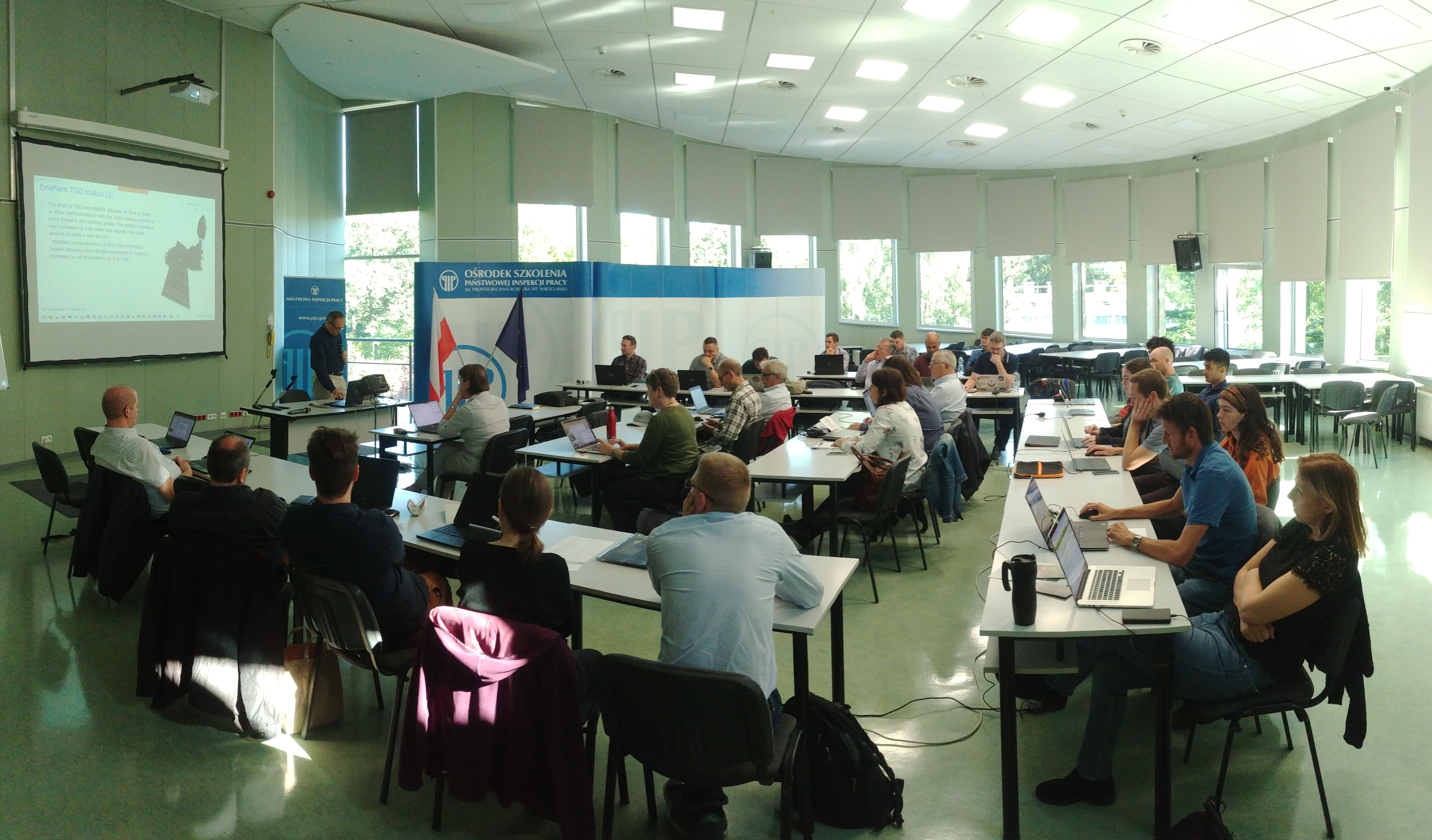
ESA-Roscosmos Trace Gas Orbiter has set new upper limits on how much methane, ethane, ethylene and phosphine is in the martian atmosphere – four so-called ‘biomarker’ gases that are potential signs of life.
Searching for biomarkers on Mars is a primary goal of the ExoMars Trace Gas Orbiter. A key biomarker of interest is methane, as much of the methane found on Earth is produced by living things or geological activity – and so the same may be true for Mars.
The ‘methane mystery’ on Mars has been ongoing for many years, with contradictory findings from missions including ESA’s Mars Express and NASA’s Curiosity rover capturing sporadic spikes and bursts of the gas in Mars’ atmosphere, fluctuations both in orbit and at the planet's surface, signs of the gas varying with the seasons, or not observing any methane at all.
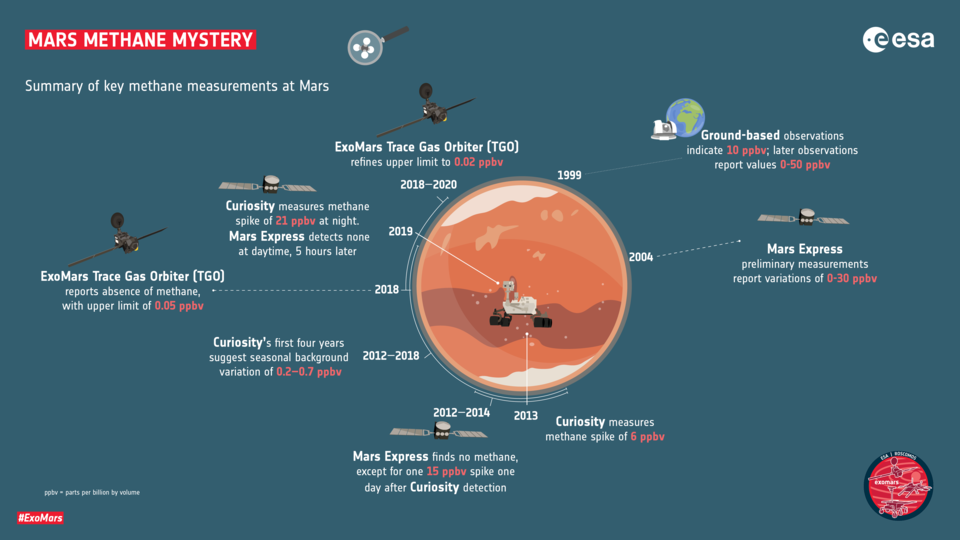
Previous estimates from Mars and ground-based missions range from 0.2 up to 30 parts per billion by volume (ppbv), indicating up to 30 molecules of methane per billion molecules. For reference, methane is present in Earth’s atmosphere at nearly 2000 ppbv.
However, the first results from the Trace Gas Orbiter, reported in April 2019, spotted no methane, instead calculating that, if present, the gas must have a maximum concentration of just 0.05 ppbv.
“We have now used the Trace Gas Orbiter to refine the upper limit for methane at Mars even further, this time gathering data for over 1.4 martian years – 2.7 Earth years,” says Franck Montmessin of LATMOS, France, Co-Principal Investigator of the Trace Gas Orbiter’s Atmospheric Chemistry Suite (ACS) and lead author of one of a trio of new papers on martian biomarkers.
“We found no sign of the gas at all, suggesting that the amount of methane at Mars is likely even lower than previous estimates suggest.”
As the orbiter’s instruments are highly sensitive, if methane is present it must be at an abundance of less than 0.05 ppbv – and more likely less than 0.02 ppbv, say Franck and colleagues. The scientists also hunted for signs of methane around Curiosity’s home, Gale crater, and found nothing, despite the rover reporting the presence of methane there.
More information can be found on the official ESA press release here
From 22nd August to 14th September 2019, NOMAD and all other instruments onboard TGO take a well-earned break! This is due to solar conjunction, when Mars is on the opposite side of the Sun, meaning that communication is impossible between Earth and Mars. For TGO, this is when the angle between the Sun and Mars, as seen from Earth, is less than two degrees.
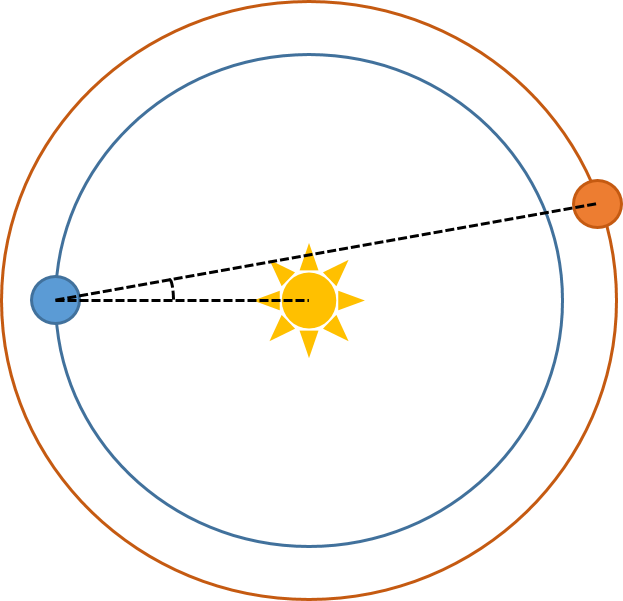
Here the Earth is represented by the blue circule and Mars is the orange circle. When the angle is too small, communication is impossible between any Mars rover or orbiter and the Earth, and so science operations cease. When communication is re-established, science can begin again.
Hakan Svedhem, the TGO Project Scientist, and Leo Metcalfe, the ExoMars ESAC Science Operations Development Manager, recently announced their retirements. During the SWT we held a virtual "cheers" to thank them for everything - Cheers!

This time it was the turn of IAA, the Institute of Astrophysics of Andalucia, to host the science team meeting. The meeting lasted 2 full days, where 18 members of the team presented their latest work on all aspects of Mars science - from instrument calibration to data analysis to atmospheric simulations and spectroscopy.
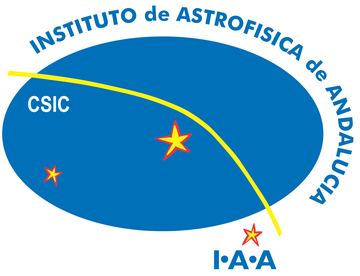
A message from P. Mitschdoerfer, ExoMars Mission Manager:
Five years ago, on 14 March 2016, our ExoMars 2016 Mission lifted-off from Baikonur on a Proton-M/Breeze-M launcher. It was a launch that could not have been better – Proton put the Spacecraft Composite (SCC) on the perfectly-right trajectory towards Mars, no Launcher Correction Manoeuvre was necessary. TGO was the heaviest Mars orbiter ever designed and launched to deliver a lander to Mars.
Our ExoMars SCC made it to Mars, Schiaparelli was successfully released from TGO and although the landing part of the EDL was not successful, Schiaparelli provided all its flight data to TGO during that critical phase such that we could perform a detailed assessment and define lessons learned and implement them for the Rover and Surface Platform (RSP) mission. TGO then fired its main engine to enter into Mars orbit. On 15 March 2017 Aerobraking started and it ended after 952 passes through the atmosphere with the Aerobraking walkout manoeuvre which was performed on 20th February 2018 at an apocentre altitude of ~1047 km. The pericentre was raised from 109 km (inside the atmosphere) to 200 km (well above). The orbital period reached with Aerobraking was 2 hours 6 minutes, and a few small propulsive manoeuvres followed to reach the final science and relay orbit with a pericentre at 360 km and an apocentre at 413 km. TGO was the first ESA spacecraft that was ever designed and used for aerobraking to reach its science orbit.
Since April 2018, TGO delivers excellent science – for instance, as of today:
• NOMAD and ACS instruments have established upper limits of methane in the atmosphere at a level more than ten times less than the previously claimed numbers of detection - this basically indicates a complete lack of methane, a phenomenal mystery that still needs to be solved.
• Hydrogen Chloride (HCI) was detected in the atmosphere for the first time.
• The first detection of Ozone in the InfraRed.
• Detection of a high variability of deuterium-to-hydrogen ratio (D/H) in water vapour over the seasons, confirming that large amounts of water have been lost over time.
• FREND has identified numerous water-rich ‘oases’ at shallow depths (0-100 cm) at near equatorial latitudes, with great implications for future explorations.
• the 20.000th image of Mars was taken by CaSSIS on 13th Dec 2020, and by now even more, including 1500 stereo pairs and detailed images of the landing sites for RSP in Oxia Planum and for Perseverance in Jezero Crater.
TGO performed its first data relay session with Curiosity on 23rd April 2018 and since then TGO serves as the first European Orbiter to routinely provide data relay for the NASA landers on Mars: Opportunity (until it stopped communicating mid 2018), Curiosity, InSight and Perseverance. TGO returned almost 58% of the Perseverance data in the first two weeks after landing.
The total science data relay volume which TGO achieved so far is remarkable (>26000 Gbit), also thanks to TGO being the first European Orbiter to routinely use Russian Ground Station Antenna as part of the ESA-ROSCOSMOS ExoMars cooperation.
WHAT AN ACHIEVEMENT! This all would not have been possible without your outstanding contribution and team spirit – you can be more than proud of this.
TGO will soon prepare for supporting our RSP mission: in August 2021 a series of TGOmanoeuvres are planned which will phase the TGO orbit to support Rosalind Franklin rover and Kazachok surface platform 1st data relay pass after landing on 10 June 2023. The challenging ExoMars 2016 mission continues and will hopefully bring further achievements together with joy and happiness.
During the annual European Geosciences Union general assembly in Vienna, NOMAD and ACS held a joint press conference to announce the first major results of the TGO mission - namely that neither instrument had detected any methane, but had determined the D/H ratio of atmospheric water and observed some interesting water vapour dynamics caused by the onset of the 2018 Mars global dust storm. Both papers were published in the journal Nature; one led by Oleg Korablev, the PI of ACS, and one led by Ann Carine Vandaele, the PI of NOMAD.
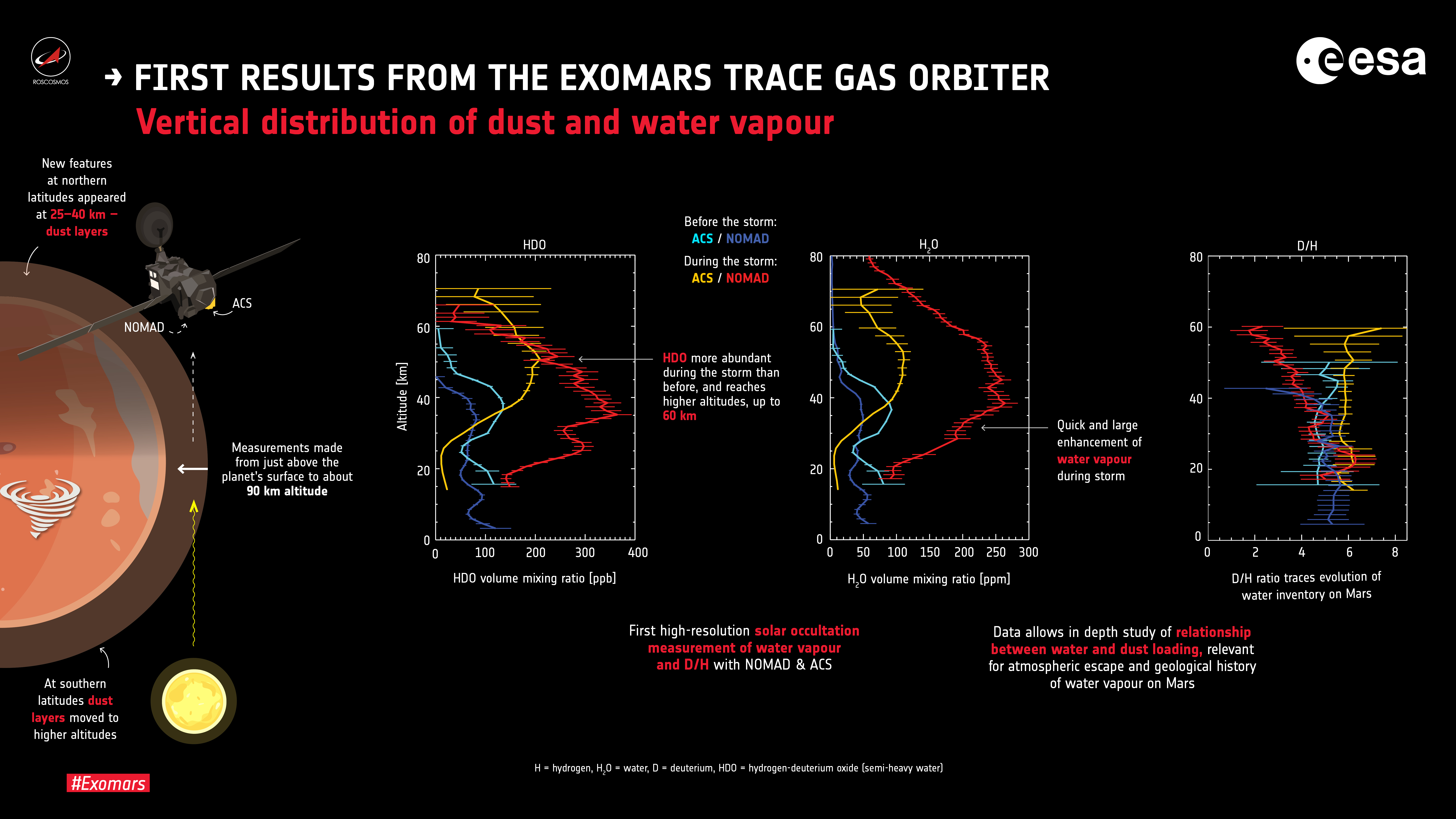
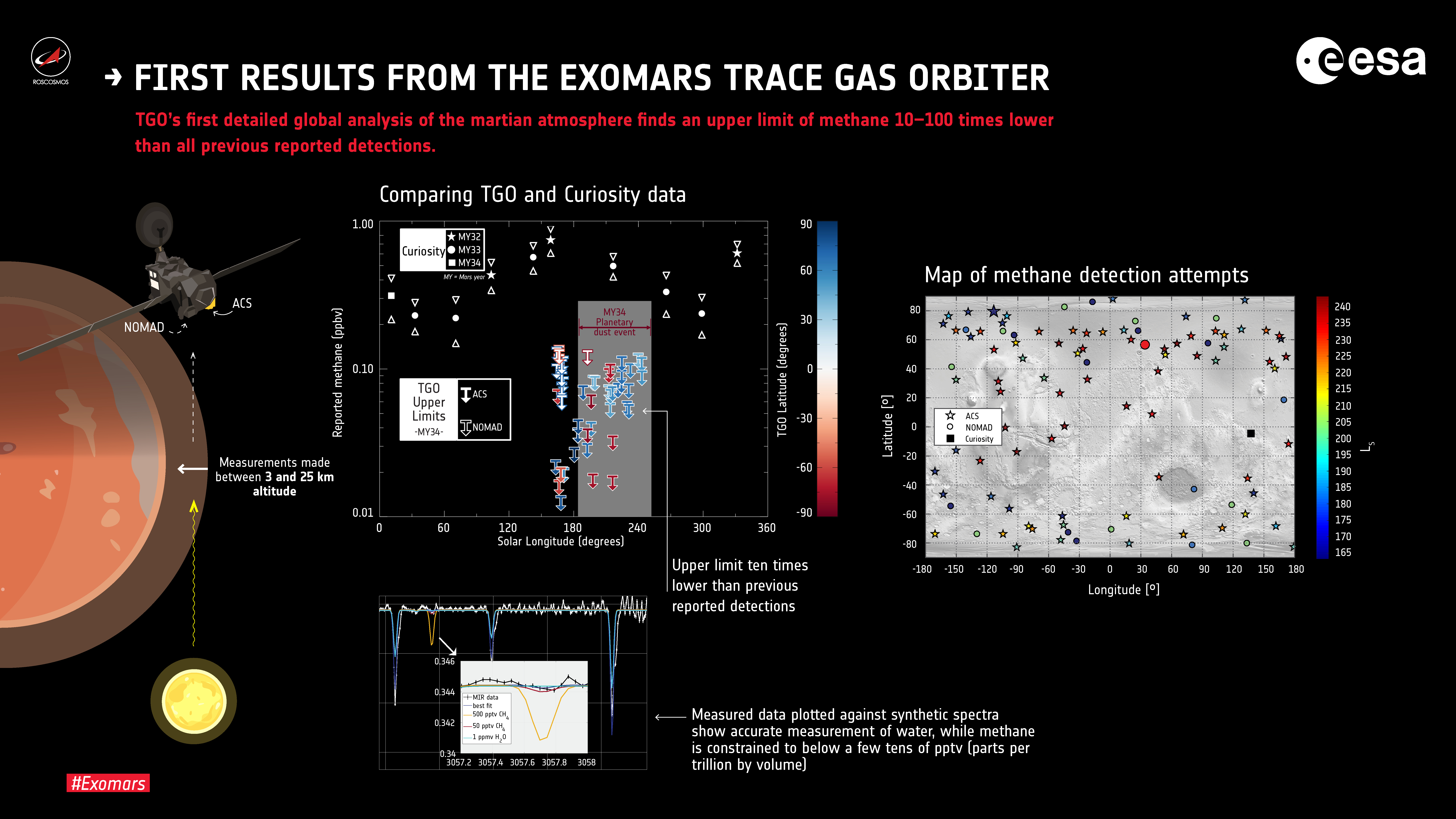
Sébastien Viscardy, a BIRA_IASB researcher, was interviewed by a Belgian journalist of De Standaard about the disappearance of water from Mars. Read more
From 28th to 31st January we held our regular science working team meeting at the headquarters of the Italian Space Agency, ASI, near Rome. In addition to the regular meeting, we also had a full day workshop dedicated to the SO channel plus a 1/2 day workshop on the UVIS channel.
Thanks to everyone at ASI for hosting us!


